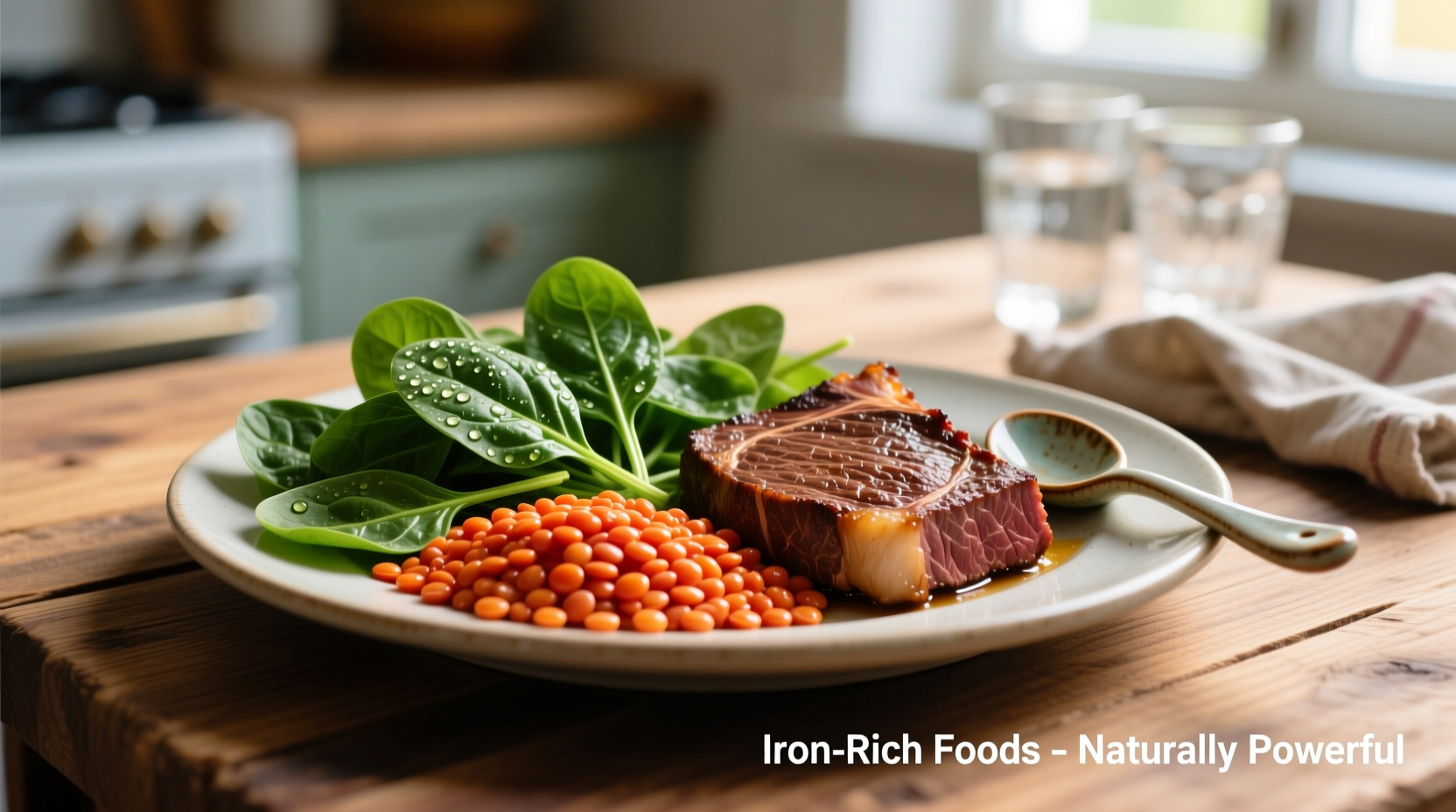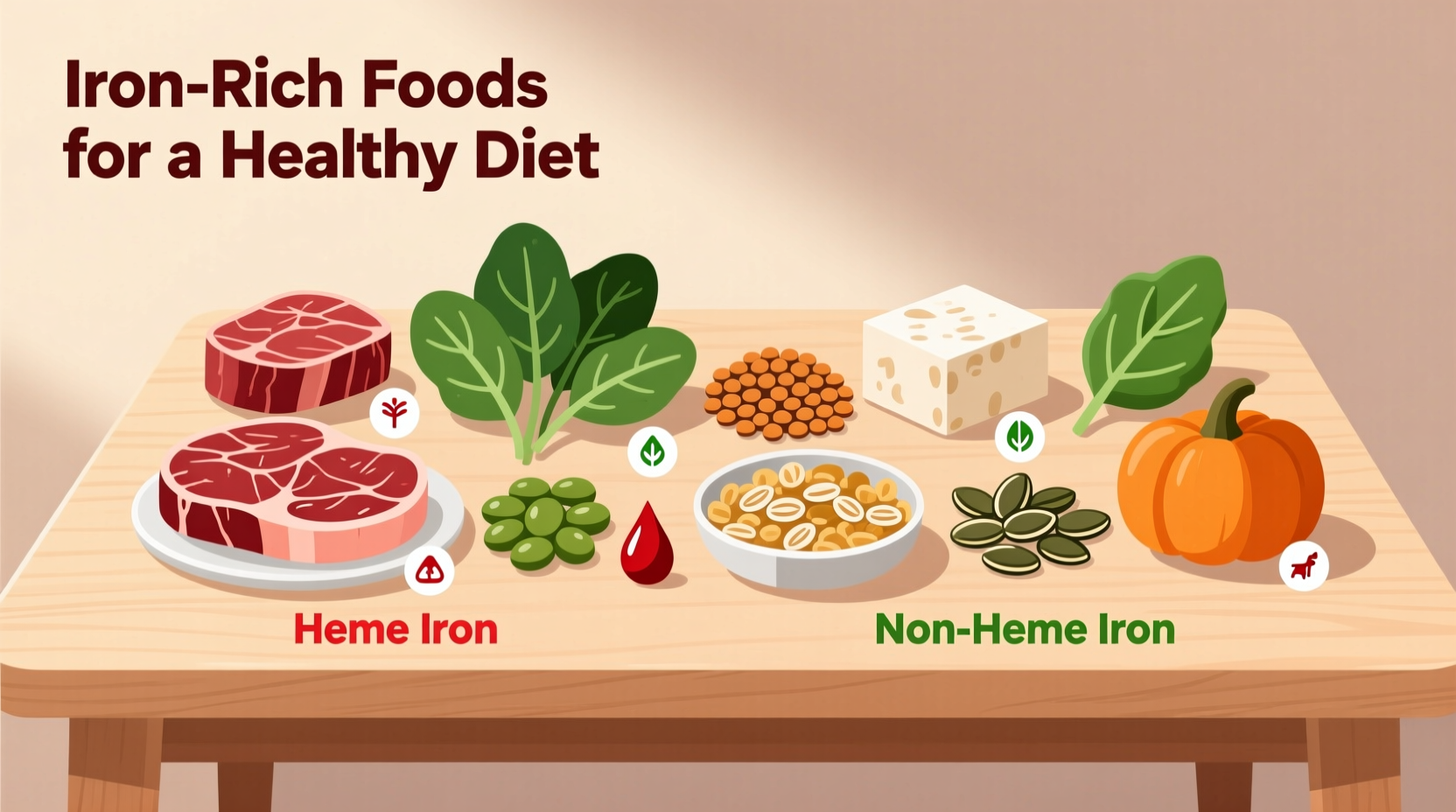The top iron-rich foods include red meat (beef, lamb), organ meats (liver), shellfish (oysters, clams), legumes (lentils, beans), spinach, tofu, and fortified cereals. Heme iron from animal sources offers 15-35% absorption, while non-heme iron from plants provides 2-20% absorption. Pair plant-based iron with vitamin C for optimal uptake.
Discover exactly which foods deliver the iron your body needs to maintain energy levels, support oxygen transport, and prevent deficiency symptoms. This guide cuts through conflicting nutrition advice with science-backed information from leading health authorities, giving you a clear roadmap to optimize your iron intake through food—whether you're omnivorous, vegetarian, or managing specific health conditions.
Why Iron Matters More Than You Think
Iron serves as the essential building block for hemoglobin, the protein in red blood cells that carries oxygen throughout your body. Without adequate iron, you may experience fatigue, weakness, impaired cognitive function, and compromised immune response. The National Institutes of Health reports that iron deficiency remains the most common nutritional deficiency worldwide, affecting approximately 10 million Americans.
Your daily iron requirements vary significantly based on biological factors:
| Demographic Group | Daily Iron Requirement | Primary Iron Challenge |
|---|---|---|
| Men (19-50 years) | 8 mg | Maintaining consistent intake |
| Women (19-50 years) | 18 mg | Menstrual blood loss |
| Pregnant women | 27 mg | Supporting fetal development |
| Vegans/Vegetarians | 1.8x higher | Lower absorption of plant-based iron |
Heme vs. Non-Heme Iron: The Absorption Difference That Matters
Understanding the two types of dietary iron explains why some iron-rich foods deliver more benefits than others:
- Heme iron (found in animal products): Absorbed at rates of 15-35%, making it significantly more bioavailable. This form directly enters intestinal cells.
- Non-heme iron (found in plant foods and supplements): Absorbed at rates of 2-20% and affected by other dietary components.
According to research published by the Harvard T.H. Chan School of Public Health, "the absorption of non-heme iron can be enhanced by consuming it alongside vitamin C-rich foods, while certain compounds in tea, coffee, and calcium supplements can inhibit absorption by up to 50%." This explains why simply eating spinach won't deliver the same iron benefits as pairing it with lemon juice.
Top 10 Iron Powerhouses Ranked by Bioavailability
Animal-Based Iron Sources (Heme Iron)
- Oysters (6 medium): 8 mg iron (45% DV) - The most iron-dense whole food available with exceptional absorption rates
- Beef liver (3 oz): 5.2 mg iron (29% DV) - Also rich in vitamin A and B12
- Ground beef (90% lean, 3 oz): 2.1-2.5 mg iron (12-14% DV) - Practical everyday option
- Sardines (canned in oil, 3 oz): 2.1 mg iron (12% DV) - Plus omega-3 fatty acids
Plant-Based Iron Sources (Non-Heme Iron)
- Lentils (cooked, 1 cup): 6.6 mg iron (37% DV) - Highest plant-based source with protein and fiber
- Spinach (cooked, 1 cup): 6.4 mg iron (36% DV) - Vitamin C pairing essential for absorption
- Chickpeas (cooked, 1 cup): 4.7 mg iron (26% DV) - Versatile for multiple cuisines
- Pumpkin seeds (1 oz): 2.5 mg iron (14% DV) - Portable snack option
- Quinoa (cooked, 1 cup): 2.8 mg iron (16% DV) - Complete protein source
- Fortified breakfast cereals: Varies (up to 100% DV) - Check labels for actual iron content

Maximizing Your Iron Absorption: Practical Kitchen Strategies
Knowing which foods contain iron is only half the battle—you need strategies to ensure your body actually utilizes that iron:
Vitamin C Pairing Principles
The NIH Office of Dietary Supplements confirms that consuming 100 mg of vitamin C (about the amount in half a cup of cooked broccoli or one medium orange) alongside plant-based iron sources can increase absorption by up to sixfold. Try these combinations:
- Lentil soup with lemon wedge on the side
- Spinach salad with strawberries and citrus dressing
- Bean burrito with fresh tomato salsa
Avoiding Common Absorption Blockers
Timing matters when it comes to iron absorption. Research from the American Journal of Clinical Nutrition shows that certain compounds can inhibit iron absorption:
- Calcium: Consuming more than 300 mg of calcium at the same meal can reduce iron absorption by 50-60%. Space dairy consumption at least 2 hours from iron-rich meals.
- Tannins in tea/coffee: These compounds can inhibit absorption by 50-70%. Enjoy your morning coffee before breakfast rather than with it.
- Phytates in whole grains: Soaking beans and grains before cooking reduces phytate content and improves iron availability.
Special Considerations for Different Dietary Patterns
For Vegetarians and Vegans
Plant-based eaters need approximately 1.8 times more iron than omnivores due to lower absorption rates of non-heme iron. The Academy of Nutrition and Dietetics confirms that well-planned vegetarian diets can meet iron needs through strategic food combinations. Focus on:
- Daily consumption of legumes (lentils, chickpeas, black beans)
- Iron-fortified cereals and breads
- Regular vitamin C pairing with iron-rich meals
- Cast-iron cookware (cooking acidic foods like tomato sauce in cast iron can increase iron content)
For Athletes and Active Individuals
Endurance athletes, particularly runners, may experience "foot-strike hemolysis" where red blood cells break down during impact activities. The International Journal of Sport Nutrition and Exercise Metabolism recommends athletes monitor iron status regularly and consider increasing iron intake by 30-70% above standard recommendations.
When Food Isn't Enough: Recognizing Deficiency and Seeking Help
While optimizing your diet should be the first approach, certain situations require professional intervention:
- Persistent fatigue despite adequate sleep
- Pale skin and brittle nails
- Shortness of breath during normal activities
- Unusual cravings for ice or non-food items (pica)
The Centers for Disease Control and Prevention emphasizes that self-treating with iron supplements without medical supervision can be dangerous. Excess iron accumulates in the body and may cause organ damage. Always consult a healthcare provider for proper testing before starting supplementation.
Putting It All Together: A 3-Day Iron-Rich Meal Plan
Implement these strategies with this practical meal framework:
| Day | Breakfast | Lunch | Dinner |
|---|---|---|---|
| Monday | Fortified cereal with strawberries | Spinach salad with chickpeas, bell peppers, and lemon-tahini dressing | Lean ground turkey with lentils and roasted broccoli |
| Tuesday | Quinoa porridge with pumpkin seeds and kiwi | Black bean soup with tomato salsa and whole grain roll | Beef stir-fry with bok choy and red bell peppers |
| Wednesday | Iron-fortified oatmeal with sliced banana and almonds | Lentil salad with roasted beets and orange segments | Salmon with sautéed spinach and sweet potato |
This meal plan strategically pairs iron sources with vitamin C while spacing out potential inhibitors. Notice how each meal contains both an iron source and an absorption enhancer, while avoiding common absorption blockers during iron-rich meals.
Common Questions About Iron-Rich Foods
Which fruit has the most iron?
Dried fruits contain the highest iron content among fruits. Specifically, dried apricots (1.4 mg per 1/4 cup), raisins (0.8 mg per 1/4 cup), and prunes (0.4 mg per 1/4 cup) offer the most iron. While fresh fruits generally contain less iron, pairing them with plant-based iron sources significantly enhances absorption.
How can I get 15 mg of iron a day naturally?
To reach 15 mg of iron daily through food: include 3 oz lean beef (2.1 mg), 1 cup cooked lentils (6.6 mg), 1 cup cooked spinach (6.4 mg), and pair each with vitamin C sources. For vegetarians, double plant-based portions and ensure strategic vitamin C pairing at every meal. The USDA FoodData Central confirms this combination delivers approximately 15 mg of bioavailable iron when properly combined.
Does peanut butter have iron?
Yes, peanut butter contains iron—approximately 0.6 mg per 2-tablespoon serving. While not among the highest sources, it contributes to daily intake, especially when paired with vitamin C-rich foods like apple slices or a glass of orange juice. Almond butter offers slightly more iron at 1.1 mg per serving.
Are eggs high in iron?
Eggs contain moderate iron (0.9 mg per large egg), primarily in the yolk. However, egg yolks also contain phosphoprotein which can inhibit iron absorption by up to 28%, according to research in the American Journal of Clinical Nutrition. For this reason, eggs shouldn't be relied upon as a primary iron source, though they contribute to overall intake.
What drinks are high in iron?
Few beverages naturally contain significant iron. However, prune juice (3 mg per cup), iron-fortified plant milks, and certain smoothies made with spinach, cocoa powder, and fortified cereals can provide meaningful amounts. The key is to pair iron-containing drinks with vitamin C sources to enhance absorption, as the NIH Office of Dietary Supplements confirms this combination significantly improves bioavailability.











 浙公网安备
33010002000092号
浙公网安备
33010002000092号 浙B2-20120091-4
浙B2-20120091-4